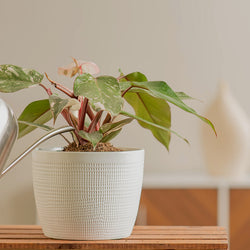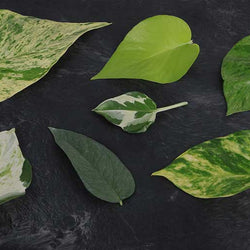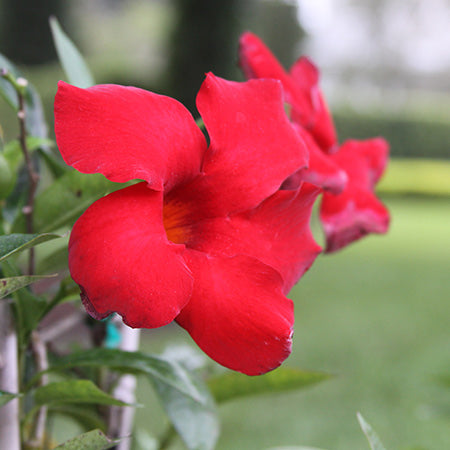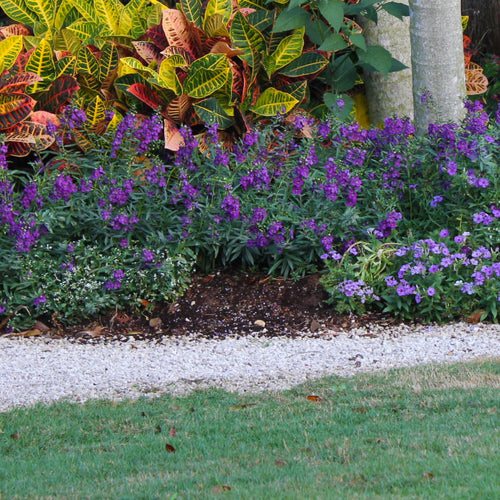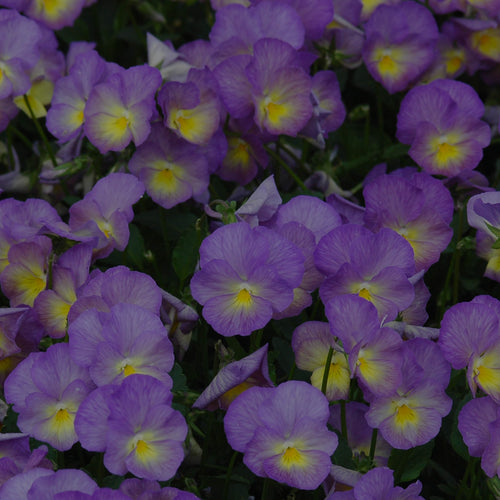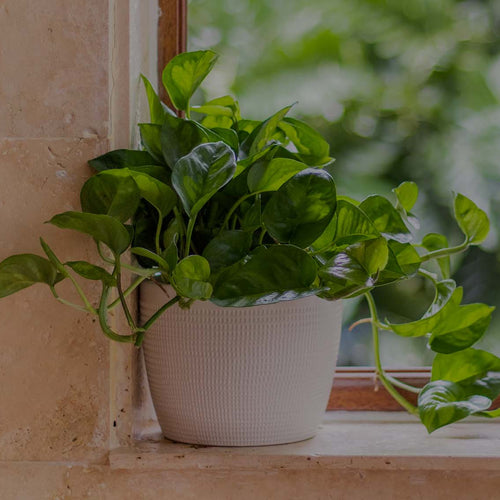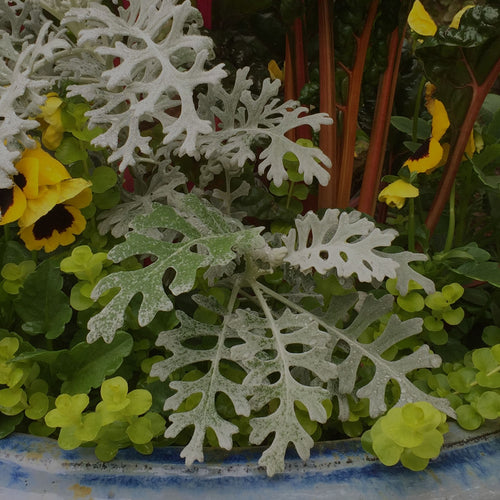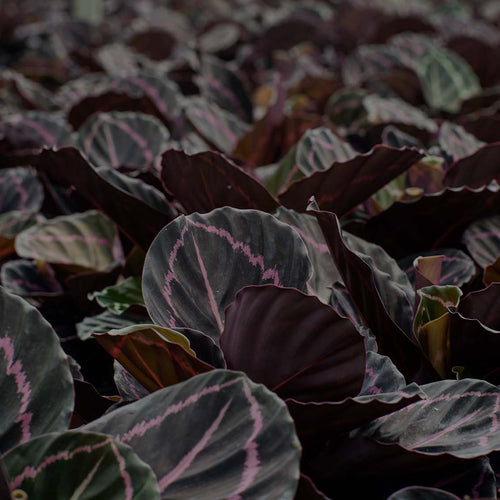For many gardeners, April is the start of the gardening season. Check out these easy tips to get your yard in shape.
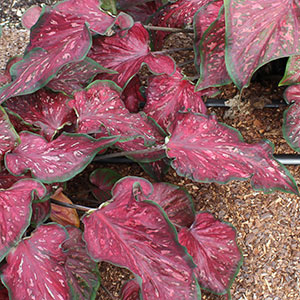 1. Plant Tender Bulbs in April
1. Plant Tender Bulbs in April
In Florida and other frost-free regions, plant bulbs such as Caladium, Tuberous Begonia, and Canna directly in the garden in April. In colder regions, get a head start on the season by planting these tender bulbs under grow lights indoors.
Tip: Plant Tuberous Begonia and Caladium bulbs with their rounded side down. New growth emerges from the top (concave) side of the bulbs.
2. Select Perennial Herbs
Chives, Lavender, Mint, Oregano, Sage, and Thyme are perennial herbs that can be planted in April in northern gardens. They require a sunny spot that receives at least 6 to 8 hours of direct sunlight a day. If you have heavy, clay soil, mix in sand and at planting time to improve drainage. Herbs will not thrive in wet, mucky soil.
Tip: Some herbs, such as Mint and Thyme, are available in a wide range of flavors and scents. Do some research before you plant to customize your herb garden to your own personal taste.
3. Grow a Salad Garden
In the North, April is the ideal time to plant salad crops such as Swiss chard, beets, lettuce, arugula, carrots, radishes, and peas. To increase yields, scatter the seeds in 4- to 6-inch wide bands or rows. There’s no need to thin the seedlings: Just let the plants grow, and harvest as you need them.
Tip: If you are short on space, grow a salad garden in a pot or planter by your kitchen door. Then, just snip what you need as you prepare meals.
4. Improve Lawns in April
Fix bare spots in your lawn now. Rake the area to remove dead grass or other debris. Then, seed with Kentucky bluegrass, perennial ryegrass, or creeping red fescue. To help germination, barely cover the seed with soil and tamp gently. Water daily until the seed germinates.
Tip: Read the label before you purchase grass seed. Look for mixes that contain less than 1 percent of “weed” or “crop” seeds. Also, never purchase grass seed that has less than a 70 percent germination rate listed on the label.
5. Plant Roses
Bare-root and container-grown roses can be planted in April gardens. For great color and easy care, select landscape varieties such as Knock Out. These tough-as-nails roses offer almost continuous bloom. Plus they look great paired with perennials such as Black-eyed Susan, Russian Sage, and Catmint. Select a location that receives at least 6 hours of direct sunlight a day.
Tip: Landscape roses such as Knock best planted in clumps of three or more. Repeat at intervals scattered through your garden.
6. Monitor Rainfall
If you don’t have a rain gauge, add one to your garden in April. For optimum growth, most plants require about an inch of moisture a week. With a rain you can track rainfall and apply additional moisture as needed. This saves money and conserves water.
Tip: Place your rain gauge in an open area where it won’t be affected by tall trees or buildings. Be sure to empty it after every rain to ensure accurate measurements and to prevent mosquitoes from breeding in the standing water.
7. Prune Spring-Flowering Bulbs
As Daffodils, Hyacinths, and Tulips fade, clip off their flower stalks. This encourages the plants to store energy in their bulbs instead of setting seed. Just be sure to leave the foliage alone until it fades naturally. The plant needs the leaves to make energy for next year’s flowers.
Tip: To camouflage bulb foliage, interplant annual flowers around the bulbs. By the time the bulbs die back completely the annuals will have carpeted the area with bloom.
8. Add Birdhouses
If you haven’t done so already, set out birdhouses designed for songbirds such as bluebirds, wrens, purple , and chickadees. Nesting songbirds will devour pesky insects that would otherwise feast on you or your garden. Select birdhouses designed with the appropriately sized entrance hole for the species you want to attract. Avoid birdhouses with perches; birds don’t use them, but predators do.
Tip: Do some research before you install a birdhouse to be sure you are mounting it at the correct height and location.
9. Replace Annuals
In frost-free regions, such as southern California and Texas, replace cool-weather annuals, such as Pansy, Snapdragon, and Primula in April gardens with heat-loving Cosmos, Petunia, Salvia, Sunflower, Verbena, Vinca, and Zinnia. In the North, hold off on planting warm-weather annuals until mid-May.
Tip: When purchasing annuals, look for short, stocky plants with rich, green foliage. Often, those that aren’t blooming yet are the best choice. Avoid leggy or wilted plants.
10. Move Houseplants
As soon as frost danger has passed, give your houseplants a vacation outdoors. Move them to a shady spot in your backyard where they are protected from high winds. Check them daily and gradually move sun-lovers such as succulents or hibiscus to a brighter location. Most houseplants respond quickly with a burst of new growth.
Tip: Outdoors, feed houseplants with a dilute solution of liquid fertilizer every time you water. Because the plants will be in active growth, they will appreciate being fed.
April Gardening Questions?
We love to talk to other gardeners. Email us your questions and we'll have one of our experts get back to you!

In Florida and other frost-free regions, plant bulbs such as Caladium, Tuberous Begonia, and Canna directly in the garden in April. In colder regions, get a head start on the season by planting these tender bulbs under grow lights indoors.
Tip: Plant Tuberous Begonia and Caladium bulbs with their rounded side down. New growth emerges from the top (concave) side of the bulbs.
2. Select Perennial Herbs
Chives, Lavender, Mint, Oregano, Sage, and Thyme are perennial herbs that can be planted in April in northern gardens. They require a sunny spot that receives at least 6 to 8 hours of direct sunlight a day. If you have heavy, clay soil, mix in sand and at planting time to improve drainage. Herbs will not thrive in wet, mucky soil.
Tip: Some herbs, such as Mint and Thyme, are available in a wide range of flavors and scents. Do some research before you plant to customize your herb garden to your own personal taste.
3. Grow a Salad Garden
In the North, April is the ideal time to plant salad crops such as Swiss chard, beets, lettuce, arugula, carrots, radishes, and peas. To increase yields, scatter the seeds in 4- to 6-inch wide bands or rows. There’s no need to thin the seedlings: Just let the plants grow, and harvest as you need them.
Tip: If you are short on space, grow a salad garden in a pot or planter by your kitchen door. Then, just snip what you need as you prepare meals.
4. Improve Lawns in April
Fix bare spots in your lawn now. Rake the area to remove dead grass or other debris. Then, seed with Kentucky bluegrass, perennial ryegrass, or creeping red fescue. To help germination, barely cover the seed with soil and tamp gently. Water daily until the seed germinates.
Tip: Read the label before you purchase grass seed. Look for mixes that contain less than 1 percent of “weed” or “crop” seeds. Also, never purchase grass seed that has less than a 70 percent germination rate listed on the label.
5. Plant Roses
Bare-root and container-grown roses can be planted in April gardens. For great color and easy care, select landscape varieties such as Knock Out. These tough-as-nails roses offer almost continuous bloom. Plus they look great paired with perennials such as Black-eyed Susan, Russian Sage, and Catmint. Select a location that receives at least 6 hours of direct sunlight a day.
Tip: Landscape roses such as Knock best planted in clumps of three or more. Repeat at intervals scattered through your garden.
6. Monitor Rainfall
If you don’t have a rain gauge, add one to your garden in April. For optimum growth, most plants require about an inch of moisture a week. With a rain you can track rainfall and apply additional moisture as needed. This saves money and conserves water.
Tip: Place your rain gauge in an open area where it won’t be affected by tall trees or buildings. Be sure to empty it after every rain to ensure accurate measurements and to prevent mosquitoes from breeding in the standing water.
7. Prune Spring-Flowering Bulbs
As Daffodils, Hyacinths, and Tulips fade, clip off their flower stalks. This encourages the plants to store energy in their bulbs instead of setting seed. Just be sure to leave the foliage alone until it fades naturally. The plant needs the leaves to make energy for next year’s flowers.
Tip: To camouflage bulb foliage, interplant annual flowers around the bulbs. By the time the bulbs die back completely the annuals will have carpeted the area with bloom.
8. Add Birdhouses
If you haven’t done so already, set out birdhouses designed for songbirds such as bluebirds, wrens, purple , and chickadees. Nesting songbirds will devour pesky insects that would otherwise feast on you or your garden. Select birdhouses designed with the appropriately sized entrance hole for the species you want to attract. Avoid birdhouses with perches; birds don’t use them, but predators do.
Tip: Do some research before you install a birdhouse to be sure you are mounting it at the correct height and location.
9. Replace Annuals
In frost-free regions, such as southern California and Texas, replace cool-weather annuals, such as Pansy, Snapdragon, and Primula in April gardens with heat-loving Cosmos, Petunia, Salvia, Sunflower, Verbena, Vinca, and Zinnia. In the North, hold off on planting warm-weather annuals until mid-May.
Tip: When purchasing annuals, look for short, stocky plants with rich, green foliage. Often, those that aren’t blooming yet are the best choice. Avoid leggy or wilted plants.
10. Move Houseplants
As soon as frost danger has passed, give your houseplants a vacation outdoors. Move them to a shady spot in your backyard where they are protected from high winds. Check them daily and gradually move sun-lovers such as succulents or hibiscus to a brighter location. Most houseplants respond quickly with a burst of new growth.
Tip: Outdoors, feed houseplants with a dilute solution of liquid fertilizer every time you water. Because the plants will be in active growth, they will appreciate being fed.
April Gardening Questions?
We love to talk to other gardeners. Email us your questions and we'll have one of our experts get back to you!
